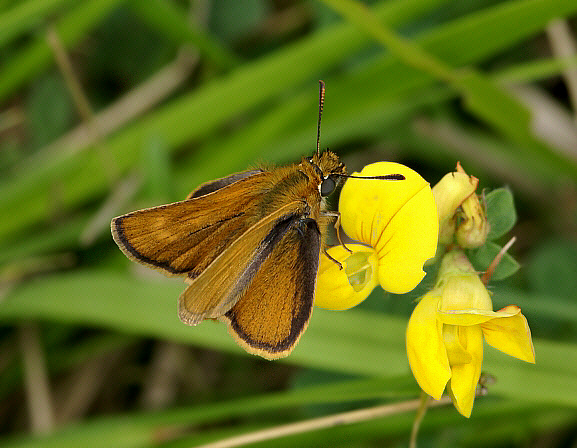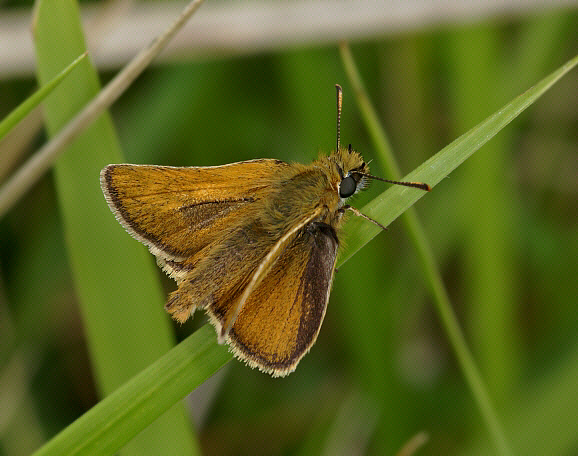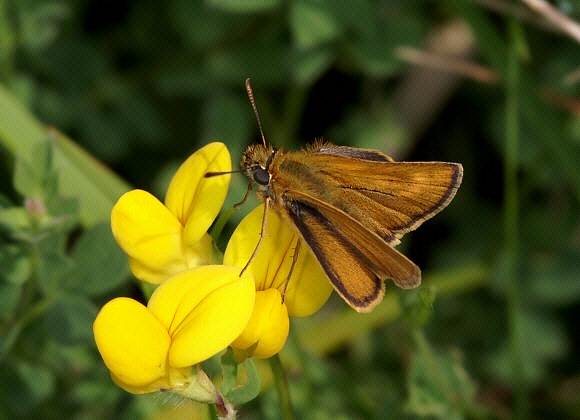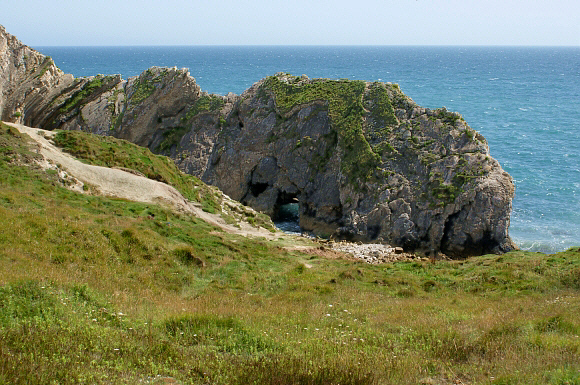 Lulworth Skipper Thymelicus acteon, male, Swanage, Dorset – Adrian Hoskins
Lulworth Skipper Thymelicus acteon, male, Swanage, Dorset – Adrian Hoskins
Introduction
The Lulworth Skipper is named after the locality Lulworth Cove in Dorset, where the butterfly was first discovered in Britain. It is found throughout most of southern and central Europe, but is absent from Scandinavia, Holland, Corsica, Sardinia and the Baltic region. Beyond Europe it occurs in the Middle East, and over much of north-west Africa.
The male is smaller, much duller, and more olive in colour than other European skippers, but could be confused with another north African species, Thymelicus hamza. The female Lulworth Skipper is slightly larger, almost as big as a Small Skipper, but has a pale golden brown ground colour. Both sexes are marked on the outer forewings with a “horseshoe” pattern of suffused golden spots – infemales this is very prominent, but in males it is very obscure and often absent.
 Lulworth Skipper Thymelicus acteon, male, Swanage, Dorset – Adrian Hoskins
Lulworth Skipper Thymelicus acteon, male, Swanage, Dorset – Adrian Hoskins
Habitats
In Britain this species is at the northern limit of it’s range, and is only found at grassland sites less than about 8 kilometres inland of the coast of south-west England.
Most Lulworth Skipper colonies in Britain are located along the steep chalk and limestone undercliffs between Swanage and Weymouth in Dorset, but there are additional colonies a few miles inland on south-facing grassland hillsides, and small isolated colonies on the southern coast of Devon.
The best sites are characterised by having extensive swathes of tor grass, growing ungrazed or very lightly grazed on warm south facing scrubby grassland slopes. It’s very noticeable for example at Swanage, where this grass carpets the hillsides, that the species is scarce on the open cattle-grazed hillsides, but abundant along the base of the hills where it breeds along a narrow fenced-off strip of land which is out of reach of grazing animals, and sheltered by bushes.

Lulworth Skipper Thymelicus acteon, male, Swanage, Dorset – Adrian Hoskins
Lifecycle
The adults normally emerge in late July and throughout August, but in recent years have begun to appear much earlier, e.g. on 31st May 2008 at Ballard Down I recorded no less than 5 males flying in a sheltered coombe; and in the hot spring of 2007 I saw a single male at the same site on 25th April.
The straw-coloured oval eggs are inserted in rows of between 5-15 into the dry sheaths of tor grass Brachypodium pinnatum, and hatch after about 10 days. Females are very choosy about where they oviposit – selecting tall clumps of flowering grasses that grow in sunny sheltered nooks, often in coombes or close to bushes. In mainland Europe additional grasses are used, including false brome Brachypodium sylvaticum, couch Agropyron repens, and wood small-reed Calamagrostis epigejos.
After about 20 days the eggs hatch. The caterpillars partly eat their egg shells, and then spin little silk cocoons within the dead grass sheaths. They immediately enter a state of diapause, aestivating and then hibernating, and do not awaken until March of the following year. At this time they disperse and live the remainder of their lives solitarily, resting during daylight hours within a shelter made by rolling grass blades into a tube, fastened with strands of silk.
The fully grown caterpillar is pale green, with a dark line along the back, narrow cream lines along the sides, and dark green prolegs. It feeds nocturnally, eating small notches out of the grass blades above and below the tube, a habit shared with several other grass feeding skippers.
The chrysalis is formed in a loose silk shelter at the base of grass tufts, and is long and thin, bright green, with pale green wing cases, and a dark lines along the back.
 Lulworth Cove, Dorset, where Thymelicus acteon was first discovered in Britain – Adrian Hoskins
Lulworth Cove, Dorset, where Thymelicus acteon was first discovered in Britain – Adrian Hoskins
Adult behaviour
Lulworth Skippers are only active in warm, sunny and calm weather, at which time their rapid zig-zagging flight is very difficult to follow. They rarely cover more than 3 or 4 metres distance on each flight, but during the course of their lives they may range over a hundred metre stretch of habitat.
They nectar avidly at rest-harrow, thistles, bird’s foot trefoil, marjoram and other wild flowers. When not nectaring they bask in the usual Hesperiine posture, half hidden amongst blades of tor grass, or occasionally on bramble bushes.
Copulation occurs at about midday, without any observed pre-nuptial ritual. Mated pairs are very reluctant to fly, and usually settle with wings fully closed, amongst tussocks of tor grass.
